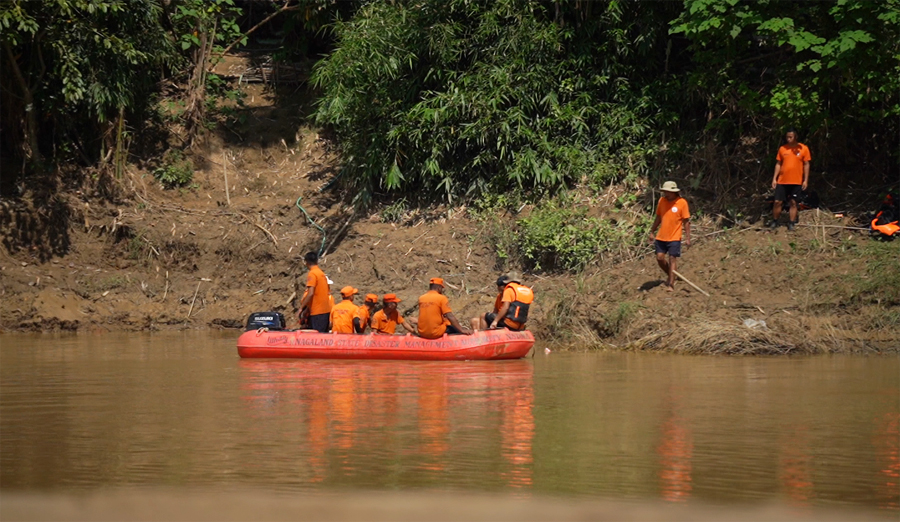Rising drownings in Nagaland prompt SDRF, village councils to issue safety warnings and precautionary measures for residents.
Share

DIMAPUR — Nagaland has reported a total of 14 drowning incidents so far in 2024–25, according to the department of Home Guards, Civil Defence, and State Disaster Response Force (SDRF), Dimapur.
Of these, six occurred in 2025 alone, with three incidents reported at Dhansiri River, two at Pimla River, and one at a fishery pond in Chekiye village.
In 2024, four incidents took place at Dhansiri River, while the two others occurred at fishery ponds.
The rising number of incidents has raised concerns among officials and local authorities about the need for enhanced safety measures and public awareness.
Swimming as basic life skill
Speaking to Eastern Mirror, SDRF Dimapur Commandant M Yingnyei Konyak described the growing drowning cases as alarming.
He felt that swimming should be taught as a basic life skill, both in schools and at home. “Swimming must be considered a necessity, not an optional activity. Parents should supervise children near water, and schools must integrate swimming as part of essential education,” he said.
The officer urged residents to avoid riversides for bathing or swimming whenever possible. If swimming is unavoidable, it should be restricted to shallow areas, and children must be closely supervised.
Some recent reports: 28-year-old man feared drowned in Chathe river
Teen drowns in Chümoukedima pond
Nagaland: Tragedy strikes twice in drowning cases
He also advised using life jackets, lifebuoys, or improvised flotation devices, and stressed that no one should swim alone. Companions are crucial, as emergencies such as cramps, fatigue, or strokes can occur suddenly.
He further highlighted the responsibility of colonies and village councils situated near rivers. “Local authorities must enforce restrictions to prevent reckless entry into river areas. These rules are vital because mishaps affect the local community directly,” he said.
Words of caution
The commandant cautioned that many drowning incidents occur due to overconfidence or lack of swimming skills. He urged beginners never to attempt swimming in open waters and recommended starting in safe, controlled environments.
Swimming under the influence of alcohol, he said, has caused several preventable tragedies.
Yingnyei also warned against underestimating open waters. Rivers in Dimapur often hide strong undercurrents, whirlpools, or deep pits created by sand mining—both legal and illegal—as well as natural formations.
Even expert swimmers can be caught off guard, he reminded; and advised parents never to leave children unattended near water bodies. He stressed that open ponds and fisheries must be barricaded for safety.
He further noted that Dimapur and Chümoukedima experience extreme heat and humidity during summer, which tempts people to visit rivers to cool off. However, this habit often leads to accidents and drowning. He urged residents to avoid riversides during summer and the monsoon season.
Regarding sand mining, he pointed out that many areas lack warning signboards. In such cases, village councils and colony authorities must take the initiative, he asserted.
If needed, they should seek assistance from the district administration to install signs and enforce necessary restrictions, he shared.
Operational challenges
The officer described several operational challenges for SDRF personnel. Many water bodies are murky, making it difficult to locate victims, while hidden currents pose risks even to trained rescuers.
Inaccessible riverbanks prevent vehicles and boats from reaching emergency sites quickly. Submerged construction debris, including iron rods and concrete, further endangers both swimmers and rescue teams. During floods or landslides, debris can become hidden hazards.
He explained that Dimapur SDRF covers a wide jurisdiction, including Chümoukedima, Niuland, and sometimes Peren, as these districts lack dedicated SDRF units. This expanded responsibility has increased the workload significantly.
Also read: Man arrested for alleged rape of student in Mokokchung; community demands justice
Precautionary measures
Village councils in Dimapur and Chümoukedima have also initiated safety measures. Sangtamtilla Village Council Chairman Asemba Sangtam said that four government-provided warning signboards have been installed near the river to alert residents.
He added that sand and gravel mining has deepened river sections to 10–15 feet, making these areas particularly hazardous. Sand mining between Nagoa Bosti and Thahekhu village has been banned to reduce risks.
Barricading fisheries and open ponds will be discussed with the deputy commissioner, he added.
Diphupar Village Council Chairman Ghuzui Shohe highlighted the use of WhatsApp alerts to inform residents of rising river levels. Youth volunteers occasionally monitor risky river areas.
While sand mining has been banned locally, no official warning signboards have been installed yet, he maintained, highlighting the importance of proper signage.
ASI Angukato K Yeptho of SDRF Chümoukedima explained that sand mining zones are extremely slippery, with some areas resembling quicksand, making movement difficult.
He also clarified that non-local individuals who assist in body recovery during search operations are not officially part of the SDRF team. Their involvement is arranged solely by the family concerned, and any participation is strictly between the family and those individuals.
On October 29, 2024, the District Disaster Management Authority (DDMA) of Chümoukedima issued a public advisory to enhance safety around water bodies. Deputy Commissioner and DDMA Chairman Polan John directed property owners and village councils to fence open and deep ponds, fisheries, and trenches to prevent accidental falls, especially among children.
Clear signs such as ‘WARNING DEEP WATER’ must be prominently displayed, it stated, adding that councils were responsible for compliance, ensuring proactive safety measures to prevent further tragedies.